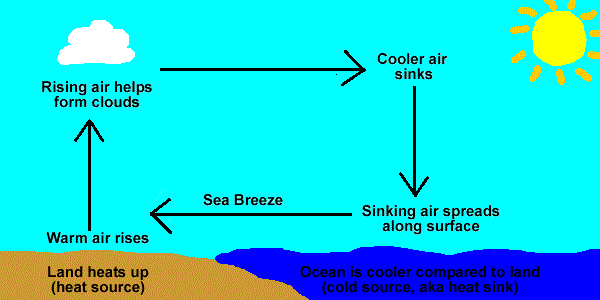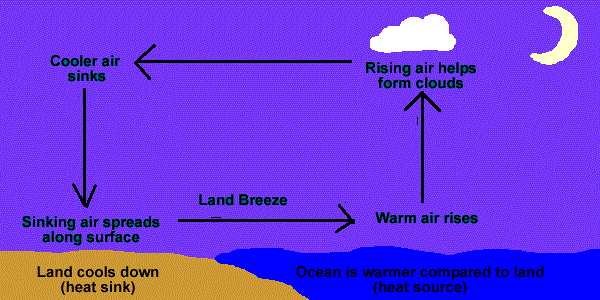7th Grade > Physics
HEAT MCQs
Total Questions : 118
| Page 1 of 12 pages
:
Thermometer definition: 1 Mark
Working: 2 Marks
A thermometer is an instrument which is used to measure the hotness of a substance.
The bulb comes in contact with an object and receives heat. This heat is conducted to the liquid inside the thermometer. This liquid which is usually Mercury expands uniformly depending on the amount of heat absorbed by the bulb. Depending on how much the liquid has expanded, the thermometer gives the respective reading.
Answer: Option C. -> Temperature of A = Temperature of B
:
C
We know,heat always transfers from a body athigh temperature to a body at low temperature. Therefore, iftwo bodies are in contactand they have the same temperature, then there is no net heat transfer between them.
:
C
We know,heat always transfers from a body athigh temperature to a body at low temperature. Therefore, iftwo bodies are in contactand they have the same temperature, then there is no net heat transfer between them.
Answer: Option A. -> Sea breeze
:
A
During the day time, land gets heated faster than water, as water has more specific heat capacity. The air above land becomes hotter than the air above sea and it rises up. So, the winds blow from sea to land to fill the void left by the hot air, which are called sea-breeze.
:
A
During the day time, land gets heated faster than water, as water has more specific heat capacity. The air above land becomes hotter than the air above sea and it rises up. So, the winds blow from sea to land to fill the void left by the hot air, which are called sea-breeze.
Answer: Option A. -> Heat flows from a hot body to a cold body.
:
A
Heat flows from a hot body to a cold body. When two bodies, one hot and another cold,come in contact with each other, the fast moving molecules of the hot body collide with the slow moving molecules of the cold body and the molecules of cold body becomes faster. As a result, the molecules of hot body become slower and the body becomes cooler, whereas the cold body becomes warmer. This continues till both the bodies reach a common temperature, i.e thermal equilibruim is attained.
:
A
Heat flows from a hot body to a cold body. When two bodies, one hot and another cold,come in contact with each other, the fast moving molecules of the hot body collide with the slow moving molecules of the cold body and the molecules of cold body becomes faster. As a result, the molecules of hot body become slower and the body becomes cooler, whereas the cold body becomes warmer. This continues till both the bodies reach a common temperature, i.e thermal equilibruim is attained.
:
Insulator with examples: 1.5 Marks
Conductor with examples: 1.5 Marks
Substances which allows heat to pass through them easily are called conductors. For example aluminum, copper and iron.
Insulators are poor conductors of heat. Insulators do not allow heat to pass through them easily. For example wool, wood, and plastic.
Answer: Option B. -> Kink
:
B
A kink prevents the mercury from falling down easily. A kinkin the glass tube resists the flow ofthe mercury as it contracts, storing the highest temperature reading. Shaking thethermometerresets the mercury back into the bulb.
:
B
A kink prevents the mercury from falling down easily. A kinkin the glass tube resists the flow ofthe mercury as it contracts, storing the highest temperature reading. Shaking thethermometerresets the mercury back into the bulb.
Answer: Option C. -> it does not have a kink
:
C
We cannot conveniently measure our body temperature using a laboratory thermometermainly because it does not have a kink.The absence of a kink results infalling of the mercury/alcohol levelas soon as thermometer is taken out to take the reading.
:
C
We cannot conveniently measure our body temperature using a laboratory thermometermainly because it does not have a kink.The absence of a kink results infalling of the mercury/alcohol levelas soon as thermometer is taken out to take the reading.
:
Land Breeze with diagram: 2.5 Marks
Sea Breeze with diagram: 2.5 Marks
Sea Breeze: In coastal areas, during the day, the land gets heated faster than the water. The air over the land becomes hotand rises up. The cooler air from the sea rushes in towards the land to take its place. The warm air from the land moves towards the sea to complete the cycle. The air from the sea is called the sea breeze.
To receive the cooler sea breeze, the windows of the houses in coastal areas are made to face the sea.

Land Breeze: At night, the water cools down more slowly than the land. So, the cool air from the land moves towards the sea.This is called the land breeze.

In both land breeze and sea breeze, heat transfer takes place by convection.
:
Conduction: 1 Mark
Difference: 1 Mark
The process by which heat is transferred from hotter end to the colder end of an object is known as conduction. It takes place usually in solids.
Conduction requires a medium for the heat to be transferred. Radiation does not require any medium for the heat to be transferred.
:
(a) Uses: 2 Marks
(b) Reason: 1 Mark
(a) Insulators are very important when we are handling substances that are hot such as cooking utensils or welders, etc. Insulators are poor conductors, they do not transmit heat from the hot part of the object to the person holding the insulated part, thus keeping them safe.
(b) No, the other end of the wooden spoon will not become cold because wood is a bad conductor of heat, i.e. wood behaves as an insulator.
















